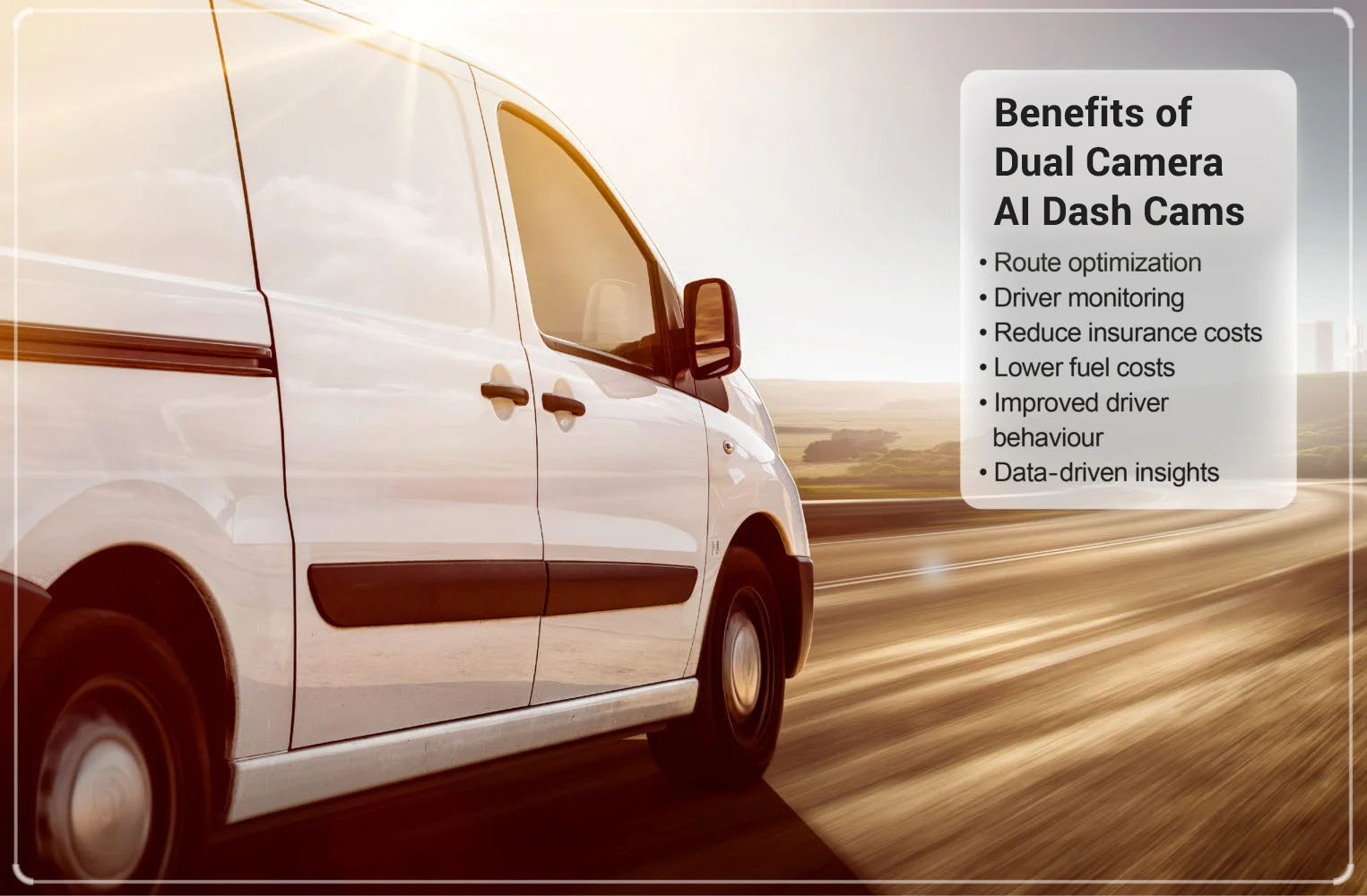If you manage a delivery service, taxi company, or a haulage fleet, your vehicles and drivers represent a considerable investment. As the demands on these services continue to change and evolve, it’s imperative that fleet managers do what they can to protect that investment and maximize the efficiency and performance of their operations. To this end, dual-camera AI dash cams are fast becoming a must-have. Let’s explore how these devices can deliver measurable benefits in terms of the safety for your fleet and save you money in the process.
Raising Driving Standards
At its most basic level, a dual-camera AI dash cam acts like an extension of the office CCTV system, recording journeys and idle vehicles and capturing incidents that happen on or off the road. Video evidence offers invaluable protection for vehicles, whether they’re leased, financed or owned outright. For example, video footage can provide clear evidence of who is at fault in the event of a collision, helping to resolve disputes and reduce insurance pay-outs.
Dual-camera AI dash cams can also play a pivotal role in raising driving standards across the board, particularly those with an integrated driver safety system. By identifying potentially dangerous behavior such as using mobile phones, smoking, and tiredness, these systems can alert the driver to take corrective action and provide rich data to help the fleet manager determine future driver training and development needs.
Installing dual-camera AI dash cams in fleet vehicles means that management can check and enforce its safety guidelines, making drivers more accountable and raising standards to ensure safe driving practices are the norm. Furthermore, with improved driving standards and safety, which thus reduces the frequency of accidents across the fleet, managers will also cut time lost to investigations and repairs and see a decrease in the cost of insurance policies.
There’s an important reputational benefit, too. In an era when an increasing number of road users share dash cam footage on social media, companies with a good track record when it comes to accountability have the means to insulate themselves from negative commentary.

Beyond Video — the Value of Data
The latest generation of dual-camera AI dash cams go beyond video recording, adding location and driving data to the record, and augmenting it with data from the vehicle CAN (controller area network) bus. These features open up several further improvements in efficiency. For example, cloud connected devices allow fleet managers to make route alterations to avoid congested roads on-the-fly.
CAN bus integration allows for different kinds of data to be captured directly from the vehicle’s engine management system, revealing key indicators such as engine idle time, fuel consumption, brake usage, average speed, and overall distance traveled. As well as highlighting drivers who regularly break the speed limits, this data can be analysed to provide insights about the performance of the vehicle, road conditions, and other factors that could impair overall efficiency for time-sensitive delivery and haulage operations.
Achieving optimal fuel efficiency for example, can reap enormous savings to operators. Ensuring that tires are inflated to the correct level and that drivers strive to remain at optimal driving speeds can significantly lower fuel bills. Across large haulage or passenger vehicle fleets, data insights into vehicle optimization and driver training can mean considerably lower operating costs.
For modern fleet management systems, the addition of Wi-Fi and high-speed mobile data completes the picture. In particular, dual-camera AI dash cams equipped with 4G wireless modules provide a crucial live window into driver and fleet performance. Meanwhile, back at base, data costs can be reduced by downloading the day’s recordings over Wi-Fi, making 4G plus Wi-Fi an ideal combination.

4G connectivity also offers scope for instant alerts when the device’s integrated G-sensor detects hard braking, acceleration, or cornering – key indicators that an incident has occurred. It can be configured to record video after such an alert, ensuring evidence is available in the case of a dispute or insurance claim. Integrated messaging support with the driver allows management to react immediately to potential accidents or emergencies.
Connectivity is also key to getting the most from both footage and data collected, with cloud integration transforming the dash cam into a true IoT device. Cloud services like Amazon Web Services can help expand how data is understood and interpreted, offering valuable insight and intelligence to help improve route planning, fuel efficiency, driver behavior, and virtually every aspect of the business.
Creating a Smarter, Safer Fleet
Armed with real-time access to vehicle location and status, plus vehicle telemetry and a pair of live video feeds, fleet operators can now be better equipped than ever to make sure their business are as safe and operationally efficient as possible.In recent years VIA has garnered extensive feedback from customers operating in the broader Fleet Management sector. This has given us valuable insights that have helped hone our approach to product development. The result is the VIA Mobile360 AI Dash Cam, a full-featured, compact dual-camera device with support for Forward Collision Warning, Lane Departure Warning, and an advanced Driver Safety System. The VIA Mobile360 D700 is AWS IoT Core Qualified and AWS Kinesis Video Streams Qualified. It comes with a 30-day free trial of the VIA Fleet Cloud Management Portal powered by Amazon Web Services (AWS), including 50 hours of live streaming with Amazon KVS.
Learn more about the VIA Mobile360 D700 AI Dash Cam here.
You can also check out this short introductory video:
